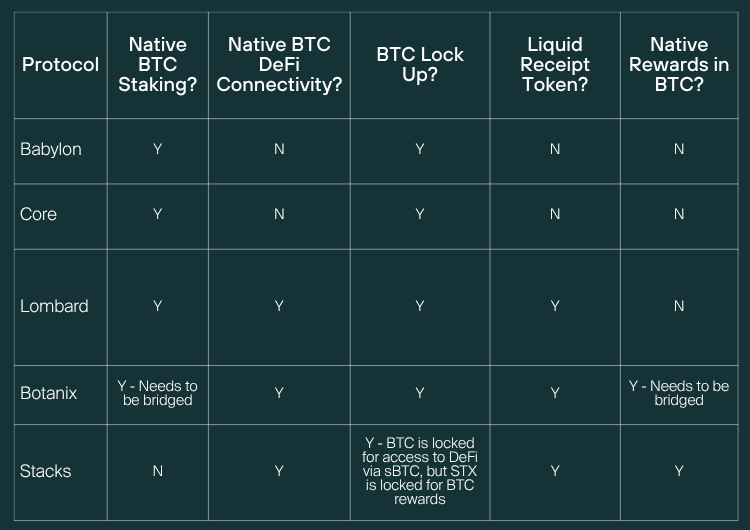The Bitcoin Finance Revolution: Part 2: Beyond HODL
Read our latest blog as we dive into “Bitcoin staking” - showing how holders can use BTC as productive capital to earn yield while maintaining self-custody.
By Sahil Sood, Client Solutions Specialist, and Sammy Balani, Technical Business Analyst, Zodia Custody
In our last blog ‘Part 1: Unlocking Value for BTC Holders’, we explored the ways in which Bitcoin (BTC) is transitioning from a passive asset to an active participant in the Ce-DeFi ecosystem. In Part 2, we dive into “Bitcoin staking” – showing how holders can use BTC as productive capital to earn yield while maintaining self-custody.
The Core Concept: It’s Not Really Staking
First, it is crucial to understand that Bitcoin remains a Proof-of-Work (PoW) blockchain. It does not have a native Proof-of-Stake (PoS) mechanism like Ethereum. When we talk about “Bitcoin Staking,” we’re referring to mechanisms that lock BTC on-chain to prove that a certain amount of capital is committed. This economic security can then be used to validate other PoS blockchains or enable new functionality on Bitcoin layers.
Bitcoin Staking – How it works:
To understand how BTC staking works, it is important to identify how value is secured, how rewards are generated, and what form those rewards take.
Using BTC to secure a PoS network:
Babylon and Core have developed two of the most progressed models for BTC staking. Both use native Bitcoin blockchain functionality to effectively lock the asset as a time-bound contract, and use this as security collateral, earning rewards for securing PoS networks.
Babylon uses the Unspent Transaction Output (UTXO ) model, whereby the participant’s available Bitcoin balance is categorised as individual units that have not been spent. These units can act like mini smart-contracts that can be relatively time-locked (via a script). The locked BTC is then delegated to a finality provider, and the provider uses the locked BTC as collateral for securing other PoS chains. Each PoS chain compensates the finality provider with its own native token for contributing to security.
In the case of Babylon, BTC holders interface with the Babylon Bitcoin Staking protocol, to create staked Bitcoin, which in-turn provides proof-of-stake security to Babylon Genesis and earns BABY native tokens as staking rewards.
For Core’s Bitcoin Staking, BTC holders use the native CLTV (CheckLockTimeVerify) absolute time-lock functionality to lock their BTC in a smart address for a specified period. The locked BTC is delegated to a CORE validator to secure the network and, in-turn, participants earn CORE token rewards proportional to their locked Bitcoin. CORE tokens can then also be staked to earn additional yield, or converted back to BTC.
This marks a fundamental shift in how BTC can be used. In both models, BTC remains fully on the Bitcoin blockchain – never wrapped, bridged, or handed to a custodian – and stays entirely under the user’s control. This multi-network staking strategy, not only boosts overall yield through diverse reward streams, but also spreads risk – protecting against slashing or underperformance on any single chain. Users can earn multiple tokens, support multiple chains, and retain full Bitcoin custody.
A ‘staked’ BTC position becomes a powerful, self-custodied engine for compounding returns across the broader staking economy. Bitcoin not only preserves value but now actively generates it across new networks.
Using BTC to secure a PoS network, whilst retaining liquidity:
Liquid Staking Protocols aim to ensure that BTC can be ‘staked’ by securing other PoS networks – as per the above approach, but without it being ‘locked’ up and not available for use in Ce-DeFi use-cases, the key focus is to maintain liquidity and enable cross-chain compatibility.
Lombard enables this through Lombard BTC (LBTC), leveraging the Babylon staking infrastructure, built as a restaking protocol. Bitcoin holders deposit BTC to a unique address, which Lombard will use to deploy Babylon BTC staking. In return holders receive LBTC tokens which are backed 1:1 by the underlying BTC.
LBTC operates across multiple EVM chains, where it can be natively minted and move seamlessly cross-chain, and therefore can be used across DeFi protocols (trading, borrow/lend, DeFi vaults) to earn additional yield, amplifying the utility of Bitcoin, all while the underlying BTC earns BABY on Babylon.
Botanix is an EVM-compatible Layer 2 built on Bitcoin, operating through an innovative bridging layer known as the ‘Spiderchain’, which effectively enables Bitcoin to support smart contracts and DeFi applications. To enable staking, Bitcoin holders bridge their BTC from the Bitcoin blockchain to the Botanix EVM. When this occurs, BTC doesn’t leave the Bitcoin network. Instead, it gets locked in a multisig wallet that’s part of the Spiderchain. In return, BTC on Botanix is minted with a 1:1 backing.
This BTC can then be deposited into a permissionless smart contract, where stBTC is minted. stBTC tokens increase in value through yield from transaction fees on the Botanix network and can be deployed on various DeFi protocols, creating added utility for yield-generation.
Similar to Botanix, Stacks is a layer for smart contracts built on the Bitcoin blockchain, where products are developed to enable Bitcoin-native DeFi. Stacks use Smart Bitcoin (sBTC) which is backed 1:1 with underlying BTC to enable trustless interactions with DeFi. BTC holders simply deposit BTC to a mainnet address and receive liquid sBTC on Stacks. This sBTC can be traded, or used for collateral purposes. For redemption, sBTC can be burnt, with smart contracts programmatically sending sBTC back for BTC to be withdrawn.
Unlike other protocols, Stacks is not a PoS chain and therefore the locked BTC cannot be natively staked on it. Stacks uses the method of ‘stacking’, where users lock one token (STX – the native Stacks token) and earn a yield in BTC – the reverse of what we see with Babylon and Core.
Across these three models, the ability to earn yield from BTC, whilst maintaining liquidity through a Bitcoin-backed asset, and using this to access the DeFi ecosystem is a commonality.
A summary of BTC Staking Mechanisms
The below table summaries how BTC can be staked, utilising these mechanisms across the protocols, to earn native yield and interact with the DeFi ecosystem, along with a high-level comparison:

Additional Bitcoin Staking Use-Cases:
Not only does BTC Staking enable holders to earn yield on their underlying BTC, it paves the way for new and innovative products to provide access to all participants in the Ce-DeFi ecosystem.
An example of this is 1Valour’s Bitcoin Physical Staking ETP. The ETP enables holders to gain indirect market exposure to Bitcoin while receiving a 1.40% yield. This is achieved through the underlying BTC being ‘staked’ using CORE. The rewards earned in CORE are converted into BTC via swapping on exchanges and attributed to the ETP’s Net Asset Value, increasing overtime as rewards are earnt and BTC grows in value.
Moreover, with confidence in digital assets and blockchain-based markets growing amongst traditional investors, collateral management can be reinvented and diversified – institutions can now deploy ‘staked’ BTC for credit facilities and offset fees with yield earned and market exposure to Bitcoin. In this model, BTC remains staked in custody and is pledged to prime brokers.
Accessing the BTC Staking revolution
As institutional adoption of BTC Staking looks to be gathering momentum, how you access and operationalise this activity is key to unlocking value in Bitcoin held.
Considerations when deploying BTC Staking include:
- How do you ensure your BTC is secured? What is your custodial model, and do you have the right infrastructure to protect assets before deploying BTC staking use-cases?
- Have you assessed native reward tokens and whether liquidity for these native rewards is readily available on secondary marketplaces? What are your liquidity requirements in relation to BTC lock-up?
- Do you have the right operational processes in place to support the additional effort required to access BTC Staking?
Ultimately, BTC Staking is now readily accessible and here to help turn BTC into a yield-generating instrument.
Share article:
Frequently Asked Questions
What does “Bitcoin staking” mean if Bitcoin is not a Proof-of-Stake blockchain?
Bitcoin operates on a Proof-of-Work mechanism, so it does not support native staking like Ethereum. “Bitcoin staking” refers instead to locking BTC on-chain to demonstrate capital commitment. This locked Bitcoin can then be used to secure Proof-of-Stake networks or enable functionality on Bitcoin layers, earning rewards while remaining fully under the holder’s control.
How do Babylon and Core enable Bitcoin staking?
Liquid staking protocols aim to maintain liquidity while BTC is used to secure PoS networks. Examples include Lombard, which issues LBTC backed 1:1 by locked BTC on Babylon; Botanix, which mints stBTC via its Spiderchain Layer 2; and Stacks, which enables BTC-backed sBTC for use in DeFi. These models allow holders to earn yield while retaining access to Bitcoin-backed assets.
How do these mechanisms keep BTC self-custodied?
Across mechanisms, BTC remains on the Bitcoin blockchain or in on-chain multisignature structures. The asset is never wrapped or handed to a custodian. This ensures holders maintain direct control of their private keys while using their BTC to secure networks and generate yield.
What new use cases are emerging from BTC staking?
BTC staking supports innovative financial products and institutional strategies. For example, 1Valour’s Bitcoin Physical Staking ETP uses BTC staked via CORE to generate yield, converting rewards back into BTC. Institutions can also pledge staked BTC as collateral in credit facilities, offsetting fees with yield while maintaining exposure to Bitcoin.
What should institutions consider before deploying BTC staking?
Institutions must evaluate how assets will be secured, ensure their custody model supports on-chain BTC protection, assess liquidity for reward tokens, and establish operational processes to manage staking activity. With the right infrastructure, BTC staking can transform Bitcoin into a yield-generating instrument while preserving institutional control.
Stay up-to-date
Sign up for the latest news, research and events from Zodia.

Get in touch
Our friendly team is always here to chat







